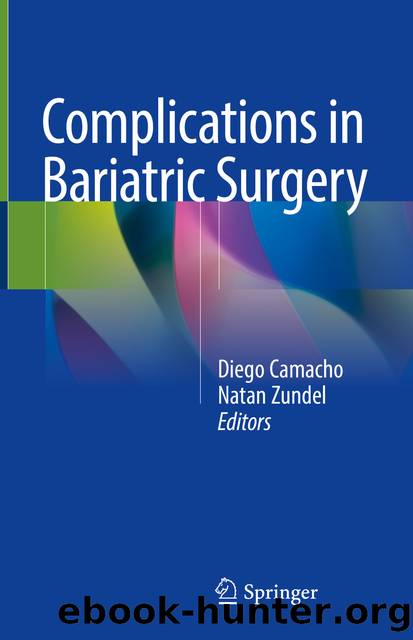Complications in Bariatric Surgery by Diego Camacho & Natan Zundel

Author:Diego Camacho & Natan Zundel
Language: eng
Format: epub
Publisher: Springer International Publishing, Cham
Interventions for Reflux After Sleeve Gastrectomy
The initial treatment for GERD symptoms following bariatric surgery should be medical. Proton pump inhibitors (PPIs) are effective in controlling symptoms in the majority of patients. However, GERD symptoms that are not controlled with PPIs pose a particular challenge in the LSG patient. Due to the altered anatomy of the GI tract following bariatric surgery, traditional surgical options like fundoplication are not an option. The most well-established method for treating GERD in this population is conversion to a LRYGB. There are however inherent risks with revision bariatric surgery. Newer procedures like radio-frequency energy delivery to the LES, the âStretta procedure â (Mederi Therapeutics, Greenwich, CT, United States) and magnetic augmentation of LES LINX® Reflux Management System (Torax Medical, Inc., Shoreview, MN, USA) offer additional options for treating these patients. Electrical stimulation therapy of the LES (EndoStim) is a new modality that involves implantation of electrodes to the sphincter, with their leads connecting to a stimulation device. This technology is not currently available in the United States, but Latin-American studies have shown its use has resulted in significant improvement in GERD-HRQL scores and median 24-h acid exposure with no adverse events. As with all endoscopic therapies, it is contraindicated in patients with Barrettâs esophagus and in patients with hiatal hernias >3 cm [37].
Stretta was approved by the Food and Drug Administration in 2000 and is an endoscopic procedure that utilizes temperature-controlled radio-frequency energy that is endoscopically delivered to the GE junction through electrodes at the end of a catheter to the lower esophageal sphincter (LES) and the gastric cardia [38]. The procedure prevents transient relaxations of the LES and reduces compliance of the GE junction, helping to prevent GERD [38]. The energy heats the tissue, causing it to swell and stiffen and prevent reflux of gastric contents. The exact mechanism in which this procedure affects GERD is not well understood. It is thought that the heat causes local inflammation, collagen deposition, and muscular thickening of the LES. Furthermore, the procedure may disrupt the nerves at the GE junction contributing to the anti-reflux effect [38].
Stretta has been extensively studied in non-bariatric patients and has demonstrated to be safe and effective. Morbidity from the procedure has been shown to be less than 0.6% and can be performed as an outpatient procedure [38]. Furthermore, outcomes have been excellent, with 91.5% of patients demonstrating improvement in GERD symptoms [38]. Results from systematic review of the efficacy of Stretta showed improved quality of life measures and reduced the heartburn standardized score [39]. Stretta also reduced the need for PPI use post-procedurally and decreased incidence of erosive esophagitis by 24% [39]. Objective measures of LES pressure were increased, and the mean acid exposure decreased after the Stretta procedure [39]. No studies have yet investigated the use of Stretta in the LSG population for management of postoperative reflux, and there is no evidence that Stretta results in improved outcomes as compared to surgical intervention. However, the procedure is an endoscopic option in the post-bariatric surgery population for patients who wish to avoid additional surgery.
Download
This site does not store any files on its server. We only index and link to content provided by other sites. Please contact the content providers to delete copyright contents if any and email us, we'll remove relevant links or contents immediately.
Psychiatry and Racial Liberalism in Harlem, 1936-1968 by Dennis A. Doyle(122)
Doctors of Deception : What They Don't Want You to Know About Shock Treatment by Linda Andre(104)
The Daly Dish Bold Food Made Good by Daly Gina;Daly Karol;(101)
The Stem Cell Hope by Alice Park(95)
The Cure for Women by Lydia Reeder(91)
Doctoring Freedom by Gretchen Long(90)
How Not to Study a Disease by Karl Herrup(89)
Pharmaceutical Medicine and Translational Clinical Research by Vohora Divya;Singh Gursharan; & Gursharan Singh(89)
9781836207139 by Miguel Gonzalez(88)
Tissue Engineering: Principles and Practices by Fisher John P(87)
Proper People: Early Asylum Life in the Words of Those Who Were There by David Scrimgeour(84)
How We Became Sensorimotor: Movement, Measurement, Sensation by Mark Paterson(83)
A Secret Mind by Kaye Kelly(83)
Medical Applications of Beta-Glucan by Gürünlü Betül;(76)
Summary and Analysis of Patient H.M. by Worth Books(73)
Mary Putnam Jacobi and the Politics of Medicine in Nineteenth-Century America by Carla Bittel(73)
Women Doctors in War by Judith Bellafaire; Mercedes Herrera Graf(71)
The Changing Face of Medicine : Women Doctors and the Evolution of Health Care in America by Ann K. Boulis; Jerry A. Jacobs(70)
Mixing Medicines by Griffin Clare;(67)
